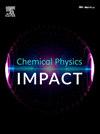聚苯胺纳米复合材料吸附结晶紫染料的等温线及动力学研究
IF 3.8
Q2 CHEMISTRY, PHYSICAL
引用次数: 0
摘要
研究了硫酸锌-聚苯胺纳米复合材料对结晶紫(CV)染料的吸附性能。通过BET、FTIR、XRD等多种表征技术对该材料的结构和功能特性进行了系统评价。傅里叶变换红外光谱(FTIR)显示了与促进染料吸附的关键官能团相关的显著振动带,并证实了锌铁氧体聚苯胺纳米复合材料的成功合成,证明了ZnFe₂O₄和PANi对应峰的移位。吸附效率与pH值有关,从pH 3.0时的42%增加到pH 9.0时的88%,而在pH 9以上,由于静电排斥效应,吸附效率下降。吸附动力学用拟二阶模型有效地描述,接触时间为60 min后的最大去除率为89%。吸附等温线的分析证实了Langmuir模型的适用性,表明其为单层吸附机制。在最佳条件下(pH为9,吸附剂用量为0.5 g / 50 ml,接触时间为60 min), ZnFe₂O₄-PANi纳米复合材料表现出吸热和自发吸附的特性。这些发现表明,该材料对CV具有高容量和强亲和力,因此将其定位为一种可行的染料去除吸附剂。本文章由计算机程序翻译,如有差异,请以英文原文为准。

Sorption isotherms and kinetics of Crystal Violet dye uptake from aqueous solution by using polyaniline nanocomposite as adsorbent
The ZnFe₂O₄-PANI nanocomposite has been developed as an adsorbent for the removal of Crystal Violet (CV) dye from aqueous solutions in the present study. The structural and functional characteristics of this material were systematically evaluated through various characterization techniques such as BET, FTIR and XRD. Fourier-transform infrared spectroscopy (FTIR) revealed significant vibrational bands associated with key functional groups that facilitate dye adsorption and confirmed the successful synthesis of the zinc-ferrite polyaniline nanocomposite, as evidenced by shifts in the peaks corresponding to ZnFe₂O₄ and PANi. The adsorption efficiency demonstrated a pH-dependent behaviour, increasing from 42 % at pH 3.0 to 88 % at pH 9.0, while a decline was observed above pH 9, attributed to electrostatic repulsion effects. The adsorption kinetics were effectively described by the pseudo-second-order model, with a maximum removal efficiency of 89 % achieved after a contact period of 60 mins. The analysis of the adsorption isotherm corroborated the applicability of the Langmuir model, indicative of a monolayer adsorption mechanism. Under optimal conditions (pH 9, 0.5 g of adsorbent in 50 ml of solution, and a 60-minute contact time), the ZnFe₂O₄-PANi nanocomposite exhibited endothermic and spontaneous adsorption characteristics. These findings suggest that this material possesses a high capacity and strong affinity for CV, thereby positioning it as a viable adsorbent for dye removal.
求助全文
通过发布文献求助,成功后即可免费获取论文全文。
去求助
来源期刊

Chemical Physics Impact
Materials Science-Materials Science (miscellaneous)
CiteScore
2.60
自引率
0.00%
发文量
65
审稿时长
46 days
 求助内容:
求助内容: 应助结果提醒方式:
应助结果提醒方式:


